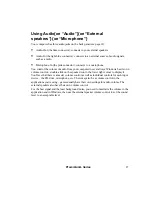
Premmia GL Series
15
Ergonomic Considerations{xe "Ergonomics"}{xe
"Carpal Tunnel Syndrome"}
Any physical activity, repeated frequently over a long period of time, may pose a risk of
serious injury. Some nerve, tendon and muscle disorders may be associated with repetitive
activities, improper work environments and incorrect work habits. Although some studies
have shown an association between long-term use of a keyboard and the development of
nerve, tendon and muscle disorders such as Carpal Tunnel Syndrome, it is still unclear
whether working at a computer causes these disorders.
We've designed your computer to be as easy to use as possible, but please follow the
guidelines in this section to reduce the risk of injury.
If you do experience pain, tenderness, swelling, burning, cramping, throbbing, weakness,
soreness, tingling and/or numbness anywhere in your body, please contact a doctor. If you
do have to work on your computer for long periods of time, make sure you vary your tasks
throughout the day, and take frequent breaks - get up and stretch, walk around.
Arrange Your Work Environment
Arrange your work environment so that you are working in an easy and relaxed position.
Get Seated
Adjust your chair according to the following guidelines:
•
Keep your body in a relaxed, upright position; make sure the back of your chair
supports the inward curve of your back.
•
Use the entire seat and backrest to support your body. The angle between your back and
thighs should be 90º or greater.
•
Place your feet flat against the floor. Extend your lower legs slightly so that the angle
between your upper and lower legs is greater than 90º.
















































